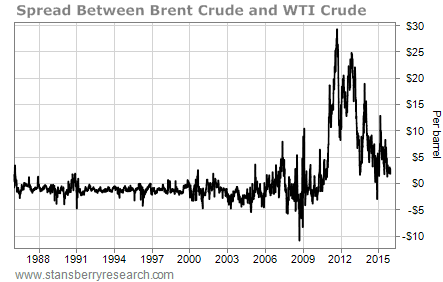Earlier this month, the U.S. dropped a bombshell on the global oil market.
It will reverse a 40-year-old ban on crude-oil exports.
[ad#Google Adsense 336×280-IA]This is good news for U.S. oil producers, who can now export their crude oil directly.
But this change will result in one clear loser… U.S. oil refiners.
Let me explain…
Refiners take crude oil and turn it into products like gasoline, diesel, and fuel oil.
If they can buy oil cheap and sell those products at high prices, they make a lot of money.
Over the past few years, they’ve made LOTS of money. Giant refiners Alon USA Energy (ALJ) and Phillips 66 (PSX) saw earnings before interest, taxes, depreciation, and amortization (EBITDA) rise 67% and 44%, respectively, from 2013 to September 2015.
That’s because for the past few years, U.S. crude oil (called West Texas Intermediate, or “WTI”) has cost less than European crude oil (called Brent crude oil).
As longtime readers know, fracking technology has allowed the U.S. to tap into incredible oil reserves in areas like the Eagle Ford and Bakken shales. Annual U.S. crude oil production is up more than 70% since 2008. The glut of oil has pushed the WTI price down. It has fallen more than 70% from its 2008 peak.
This caused Brent to trade at a big premium to WTI. The chart below shows the spread between the price of Brent and WTI over the past 30 years.

As you can see, from 1986 to the end of 2005 (the start of the shale boom), Brent traded at a slight discount to WTI. The average price was about $1.34 less than a barrel of WTI. That’s because WTI is a higher-quality crude oil. However, after 2005, Brent’s price commanded an average premium of $5.44 per barrel. The spread spiked to nearly $30 per barrel in 2012.
In the refining business, where good profits are measured in single dollars per barrel, a double-digit spread was too good to be true… Refiners couldn’t legally export crude oil from the U.S. So they couldn’t take advantage of this spread directly… But refiners could export refined products like gasoline and diesel fuel.
Refined products made from cheap WTI were fetching high prices in Europe. And refiners took full advantage…
According to the U.S. Energy Information Administration, U.S. exports of refined goods more than doubled from 1.6 million barrels per day in March 2010 to 3.3 million barrels per day in February 2013.
And refining stocks soared. Shares of Alon and Phillips 66 tripled from 2011 to early 2015.
But now, the spread has closed. The price of WTI is around the same as the price of Brent. And with the U.S. allowed to export crude oil again, the price of WTI could go higher than the price of Brent.
So U.S. oil refiners will see their profits shrink. This hasn’t happened yet, but it will.
As a result, shares of these companies are starting to fall. Phillips 66 is down more than 10% from its high in November. And Alon is down 33% since its peak in August. That’s a trend I expect to continue.
If you own U.S. refining stocks, take profits today… or at least tighten your stops.
Good investing,
Matt Badiali
[ad#stansberry-ps]
Source: Growth Stock Wire


